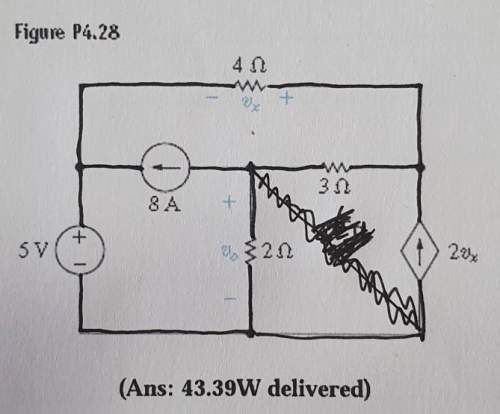
Engineering, 19.08.2019 14:20 sipstick9411
Use mesh-current method to find the power developed in the voltage source in the circuit in fig. p4.28.
*ignore scratched out branch on circuit


Answers: 1
Another question on Engineering

Engineering, 03.07.2019 15:10
If you were designing a bumper for a car, would you prefer it to exhibit elastic or plastic deformation? why? consider the functions of a bumper in both a minor "fender-bender" and a major collision.
Answers: 1

Engineering, 04.07.2019 18:10
Ariver flows from north to south at 8 km/h. a boat is to cross this river from west to east at a speed of 20 km/h (speed of the boat with respect to the earth/ground). at what angle (in degrees) must the boat be pointed upstream such that it will proceed directly across the river (hint: find the speed of the boat with respect to water/river)? a 288 b. 21.8 c. 326 d. 30.2
Answers: 3

Engineering, 04.07.2019 18:20
An open feedwater heater operates at steady state with liquid entering at inlet 1 with t? = 40°c and pl = 1 .2 mpa. water vapor att2-200°c and p2 = 1.2 mpa enters at inlet 2. saturated liquid water exits with a pressure of pa 1.2 mpa. neglect heat transfer with the surroundings and all kinetic and potential energy effects, determine the mass flow rate of steam at inlet 2 if the mass flow rate of liquid water at inlet 1 is given as 2 kg/s.
Answers: 3

Engineering, 04.07.2019 19:10
An electric kettle is made out of stainless steel, weighs two pounds (when empty) and is equipped with a heating element that consumes 2 kw of electricity. assuming that the water and the kettle are at the same uniform temperature at any moment of time, calculate the shortest possible time to bring 2 quarts of water from room temperature to the onset of boiling
Answers: 2
You know the right answer?
Use mesh-current method to find the power developed in the voltage source in the circuit in fig. p4....
Questions

History, 19.11.2020 21:20


Chemistry, 19.11.2020 21:20




Arts, 19.11.2020 21:20

Social Studies, 19.11.2020 21:20



History, 19.11.2020 21:20



Mathematics, 19.11.2020 21:20

Arts, 19.11.2020 21:20







